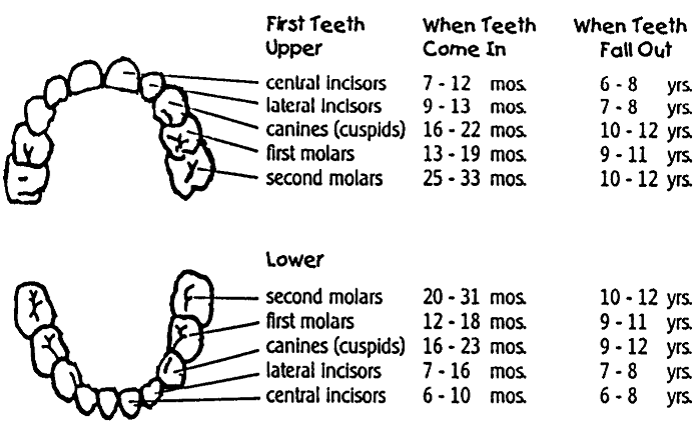Find ways to cope with teething, strategies for brushing and free dental services for kids.
Most children begin teething at about six months of age. By three years of age, your child should have all of his or her first set of teeth – 20 in total.
Coping with teething
A common sign that a new tooth is coming is increased drooling. Teething may cause some discomfort, making your baby fussy. Your baby may also not want to eat.
- Give your toddler extra love and patience.
- Allow your toddler to chew on a clean, chilled teething ring, teething toy, or clean wet face cloth. Check the condition of teething rings frequently. Throw away any teething rings that are cracked or worn.
- Teething gels and ointment are not recommended.
- Teething cookies or biscuits are not a good choice because these can stick to your baby's teeth and cause tooth decay.
Teething does not cause fevers. If you have any concerns, call 8-1-1 to speak with a nurse or contact your health care provider.
Baby teeth are important
It is a common misconception that baby teeth are not important because they will fall out anyways. Baby teeth are important for:
- Eating
- Proper jaw development
- Guiding adult teeth in place
- Speaking clearly
Some baby teeth are not replaced by permanent teeth until the age of 13.
Start healthy habits early
- Before teeth appear, wipe your baby’s gums daily with a clean wet cloth.
- Once baby teeth appear, gently brush your baby’s teeth (once in the morning and after the last evening feeding) with a child’s toothbrush.
- Use a rice grain-sized portion of fluoride toothpaste. As more teeth appear, gradually increase the amount of toothpaste up to a pea-sized amount by the age of 36 months.
- Keep toothpaste out of your toddler’s reach. Children should not swallow large amounts of fluoride toothpaste.
- Your child will need your help with brushing until they are able to write, not print, their own name.
- When the teeth are touching and brushing is well established, parents should then floss their child’s teeth daily.
Strategies to brushing
Find a comfortable position
- Place your child on a couch or bed, with their head in your lap.
- Lay your child on the floor with their head placed between your legs.
- Sit your child in a high chair where you can stand behind and brush.
Make brushing fun
- Make up a song to sing while brushing.
- Make up a game about “chasing the sugar bugs away."
Tips for flossing
Once your toddler’s teeth are touching and brushing is well established, you can begin to floss once a day.
- Ease the floss between the teeth. Curve the floss in a “C” shape and gently rub it up and down along the tooth.
- Always assist with flossing. Your toddler could damage the gums if done by him or herself.
Preventing tooth decay
- Do not share toothbrushes.
- Limit the sharing of eating utensils.
- Avoid licking your baby’s soother to clean it.
- Avoid sipping on sugary drinks all day such as juice, formula or milk. Water is a good choice at any time.
Use soothers properly
Find tips on proper soother use.
Visit your dentist
The first dental visit is recommended within six months of the first tooth coming in or by your baby’s first birthday. The dentist will recommend the frequency of your child’s visit. Find a dentist near you.
Free dental care services for children
BC Healthy Kids Program
The BC Healthy Kids Program helps low income families with the costs of basic dental care and prescription eye wear. If you are on premium assistance through B.C. Medical Services Plan (MSP), your toddler may be eligible for dental benefits.
Fluoride Varnish Program
We offer a free fluoride varnish program for children 36 months and under, who are not under the regular care of a dentist. Fluoride varnish is a paint-on fluoride that hardens to the outer surface of the teeth and takes about one minute to apply. It is easy and safe.
Our dental staff will:
- Provide a risk assessment for tooth decay to determine if your child requires fluoride varnish.
- Provide appropriate dental health information to promote healthy dental behaviours.
- Help families access dental care and available resources.

